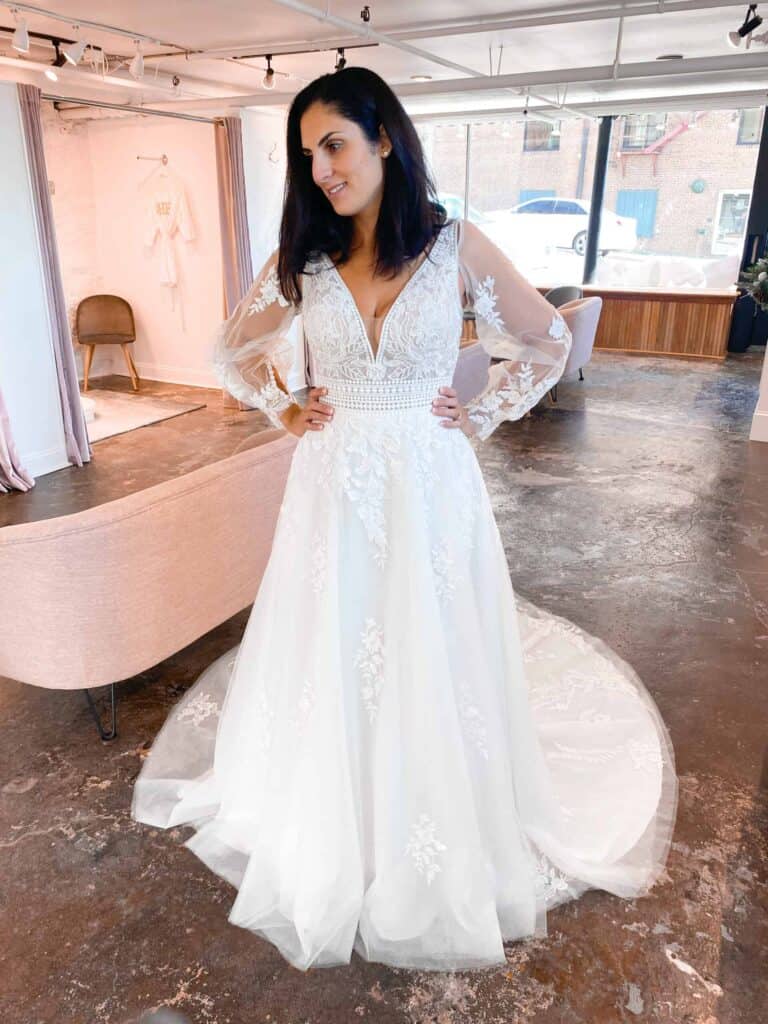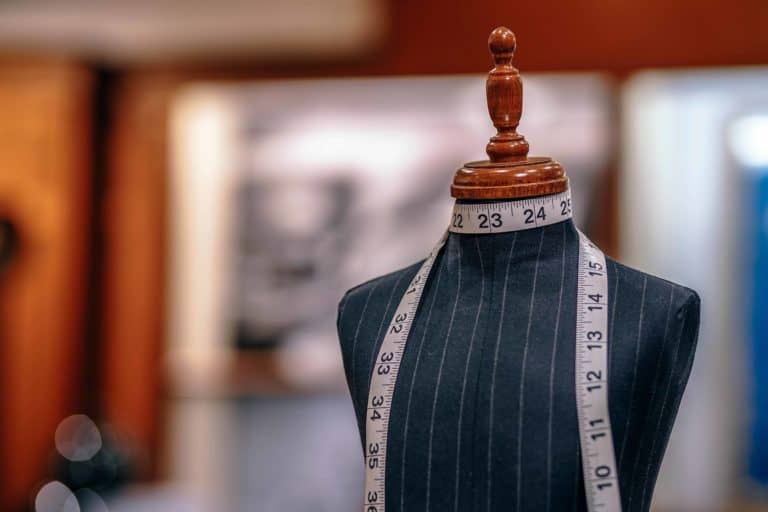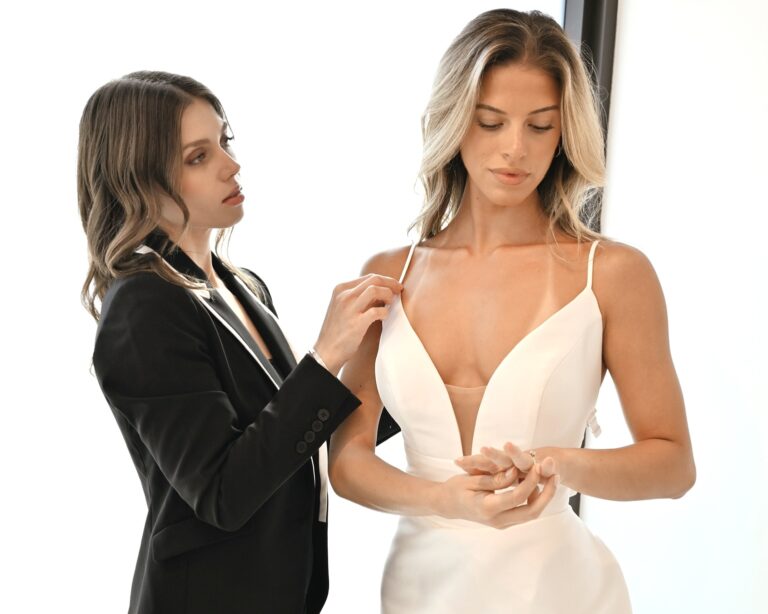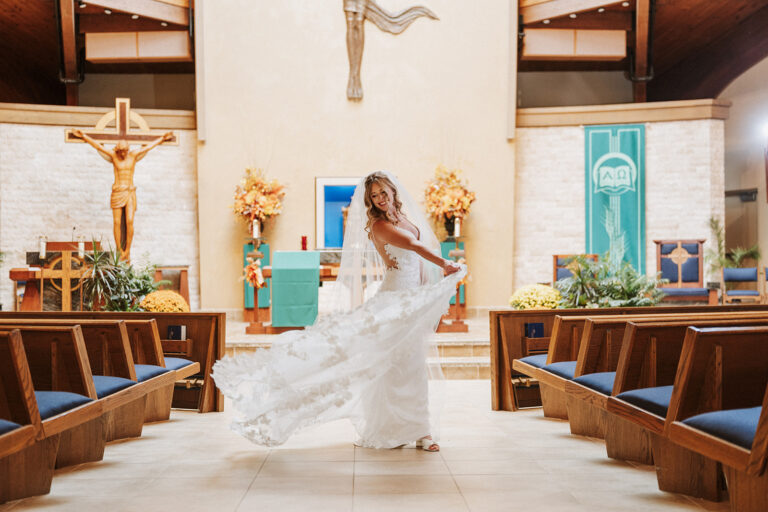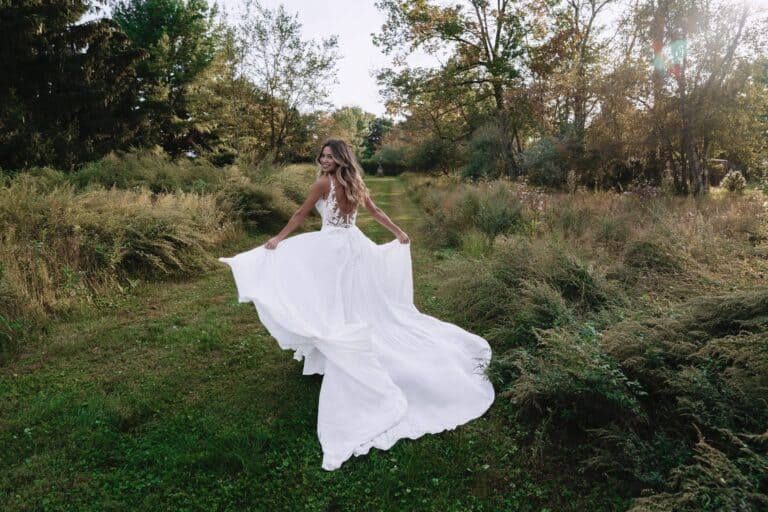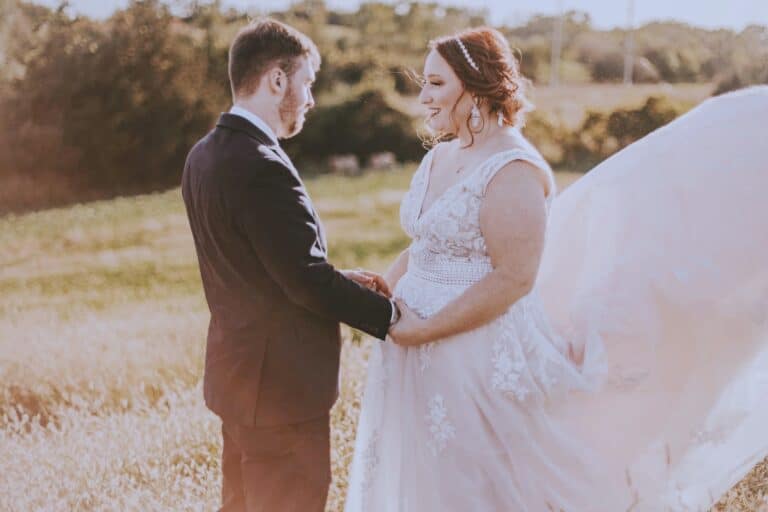Ultimate Guide to Wedding Dress Overskirts
If you want to be a one-of-a-kind bride with a two-in-one dress combination, a wedding dress overskirt might be the answer for you. An overskirt can be added to any bridal ensemble to give an elegant, romantic, or whimsical look. Their versatility across fabrics and styles allows each bride the option to wear one no matter what dress they choose.
We’ve put together a guide to wedding dress overskirts to help you decide if wearing one is the right option for you on your special day.
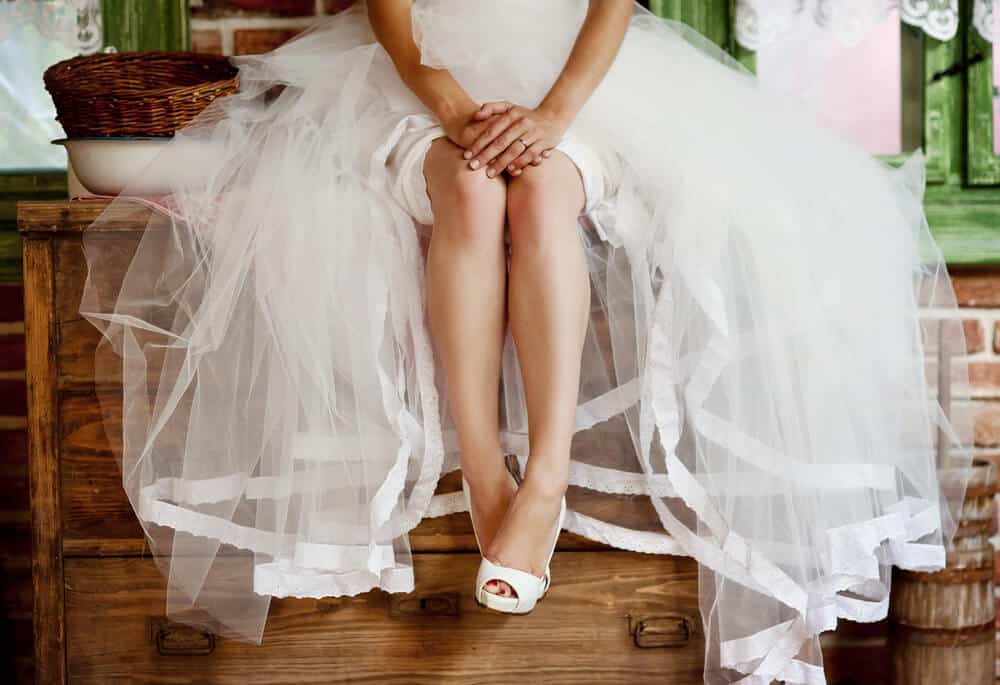
What Is a Wedding Dress Overskirt?
A wedding dress overskirt is a detachable piece of fabric that is worn over a wedding gown, typically fastened at or slightly above the waistline. It can add volume, dimension, and an overall unique look to the bride’s wedding dress.
Coming in various styles and fabrics, overskirts bring a customizable touch to the bride’s wedding attire, allowing them to express personal style while also showcasing a versatile two-in-one look.
Types of Wedding Dress Overskirts
There are many different styles of overskirts, from different materials to designs, allowing each bride who wears one to showcase a completely different style than the next. Some of the most common types of wedding dress overskirts are listed below.
Tulle Overskirt
Tulle is the perfect material for brides searching for a lightweight and airy overskirt. Adding volume without weighing you down, tulle overskirts offer a romantic and ethereal look and can be styled in various ways to achieve the desired effect.
Chiffon Wrap
Chiffon overskirts are similar to tulle in the way that they provide a soft, romantic look. Chiffon drapes beautifully over wedding gowns, adding movement and grace to the silhouette. This material is also easy to style in different ways, like draped to one side or tied in a bow at the waist, adding even more versatility to the bride’s overall look.
Lace Overlay
Lace overskirts add a touch of elegance and sophistication to any wedding dress. They can feature intricate lace patterns that complement the dress’s design, providing texture and visual interest. Depending on the desired level of coverage, lace overskirts can be sheer or layered.
Ruffle Overskirt
Overskirts with layered ruffles add drama and volume to wedding dresses. With cascading layers of fabric, they create a statement by giving the dress a whimsical and romantic vibe. Layered ruffle overskirts can vary in fullness and length for a customized look.
Benefits of Wedding Dress Overskirts
Incorporating overskirts into your wedding day look offers several benefits for brides, enhancing style and practicality on their big day. Below are a couple of key benefits.
Versatile Look
A wedding dress overskirt allows brides to easily switch up their looks between the ceremony and reception without ever taking off their wedding dress. By simply adding or removing the overskirt, brides can achieve two unique looks, offering flexibility and practicality for their wedding day.
This can be especially pleasing for brides who want to make a statement during the ceremony but aren’t fond of the idea of carrying heavy fabric around their waist all night.
Comfort and Mobility
Despite the added volume, overskirts are often designed to be lightweight and easy to move in, ensuring that brides can dance, walk, and mingle with ease on their wedding day. Additionally, overskirts can be detached if you decide you’re tired of lugging around added fabric.
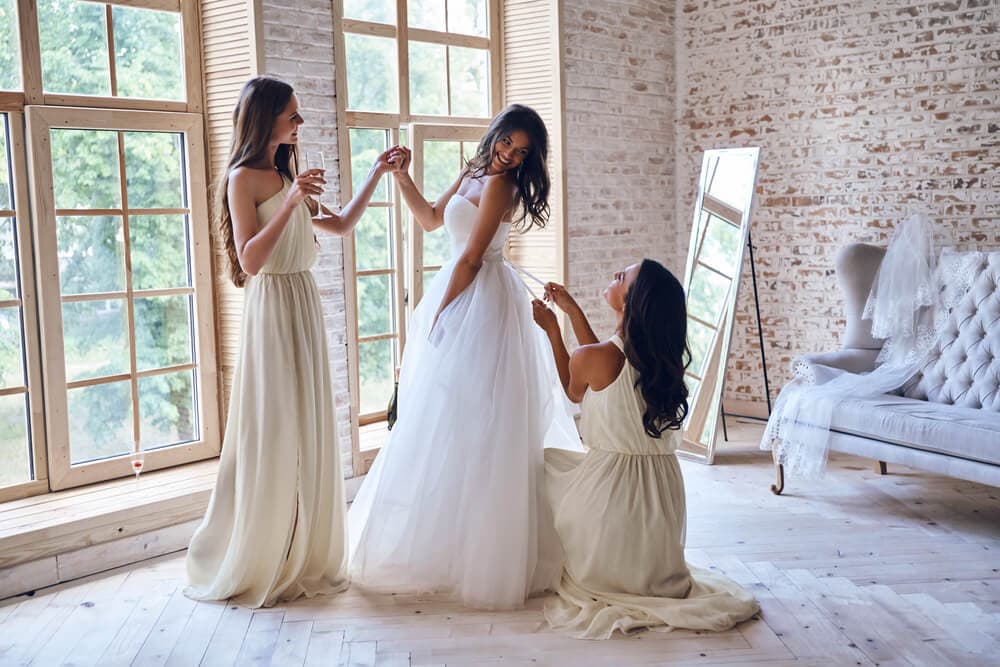
Common Questions About Wedding Dress Overskirts
Finding the perfect wedding dress overskirt can raise several questions. From style choices to practical considerations, navigating the world of bridal fashion can be both exciting and overwhelming without knowing exactly what you’re looking for, so we’ve answered some of the most common questions regarding wedding dress overskirts.
How Does an Overskirt Attach to Your Wedding Dress?
An overskirt can attach to a wedding dress in different ways, depending on the design of the dress. No matter the method of attachment, though, overskirts will almost always sit at or around the waistline to enhance the bride’s silhouette.
Some common ways overskirts are attached to a wedding dress are:
- Button or Snap Fastenings: Some skirts feature buttons or snaps along the waistband or inside the waistline of the skirt. They align with corresponding buttons or snaps on the waistline of the wedding dress for a securely fastened fit.
- Hooks and Eyes: Some overskirts may use hooks and eyes for attachment. Similar to buttons or snaps, hooks and eyes are positioned along the waistband of the overskirt and the waistline of the dress to ensure a secure fit.
- Velcro: In some cases, overskirts may use Velcro strips for attachment. Velcro provides a convenient and adjustable way to secure the overskirt to the dress, allowing for easy removal and reattachment as needed.
- Ties or Ribbons: Certain overskirts may feature ties or ribbons that are wrapped around the waistline of the dress and tied in a bow or knot to secure the overskirt in place. This method offers flexibility in adjusting the fit of the overskirt, as well as an additional design aspect.
- Zippers: While less common, some overskirts may incorporate zippers for attachment. The zipper is typically located along the waistband of the overskirt and aligns with a corresponding zipper on the dress, allowing the overskirt to be zipped on.
Does a Wedding Dress Overskirt Need Alterations?
Alterations for an overskirt greatly depend on how the skirt is designed and how it fits and interacts with your wedding dress. A seamstress will inspect the waistline compatibility of both the overskirt and dress to ensure a perfect fit.
Then, they’ll examine the length of the overskirt and make adjustments, if needed, to better complement the wedding dress. Lastly, your seamstress may need to alter the attachment method to ensure a secure and seamless fit.
Is an Overskirt for a Wedding Dress Customizable?
Overskirts can be customized in many different ways to tailor to a bride’s individual preferences and style. Some ways that an overskirt can be customized for a wedding dress include fabric selection, style, length, attachment method, and embellishments. Brides can work with designers or seamstresses to customize their overskirts exactly the way they want it.
What Style Wedding Dress Goes With an Overskirt?
The short answer is almost any style, as long as you’re working with a seamstress to ensure proper fitting. If you’ve fallen in love with a specific dress that doesn’t come with an overskirt, it can always be altered to include one.
However, one of the main purposes of an overskirt is to enhance the bride’s figure in the dress, so some wedding dresses work better with overskirts than others. Here are a few examples of wedding dress styles that fit well with an overskirt:
- A-line Dress: A classic A-line silhouette provides a balanced look when paired with an overskirt. The overskirt can add drama and volume, while the A-line shape keeps the overall look elegant and flattering.
- Ball Gown: A ball gown with a full skirt can create a fairy-tale effect when combined with an overskirt. This combination can add extra volume and dimension to the skirt, making a grand statement.
- Mermaid/Trumpet Dress: For a more fitted silhouette, a mermaid or trumpet dress can be paired with an overskirt to add flair and volume at the bottom. This combination is great for brides who want to accentuate their curves while adding a touch of drama.
- Sheath/Column Dress: While less common, a sheath or column dress can also be paired with an overskirt for a unique look. The overskirt can provide contrast and visual interest to the sleek silhouette of the sheath dress.
- Tea-Length or High-Low Dress: If you’re going for a more unconventional look, consider pairing an overskirt with a tea-length or high-low dress. This combination can create a fun and playful vibe, perfect for a less formal wedding or a casual outdoor ceremony.
One question we receive quite a bit is, “How can I wear an overskirt if my wedding dress already has a long train?” Don’t worry; it’s possible! A seamstress can bustle the train to prevent it from trailing past the overskirt’s fabric. Wedding dresses that come with a train and overskirt are already designed so that the train will not hang outside of the skirt, therefore not requiring a bustle.
If you’re interested in looking at wedding dresses with overskirts or adding an overskirt to your dress, contact the stylists at Savvy Bridal. We carry a diverse collection of wedding dresses, and our stylists are happy to help you find your perfect one. Schedule an appointment at our Kansas City or St. Louis location today!

